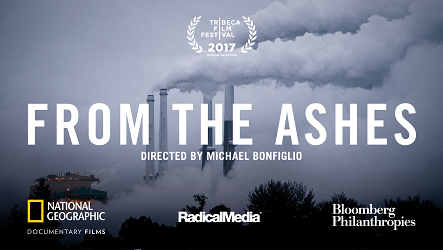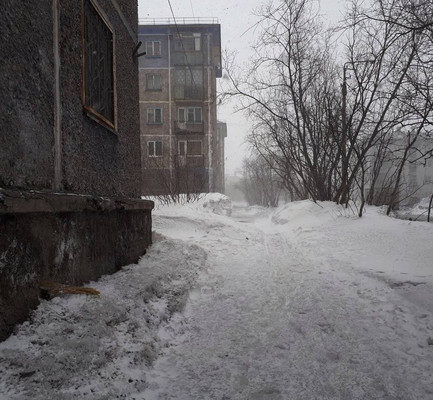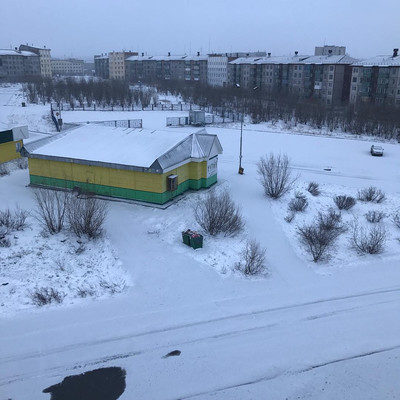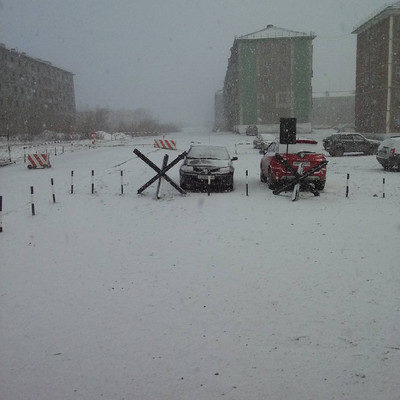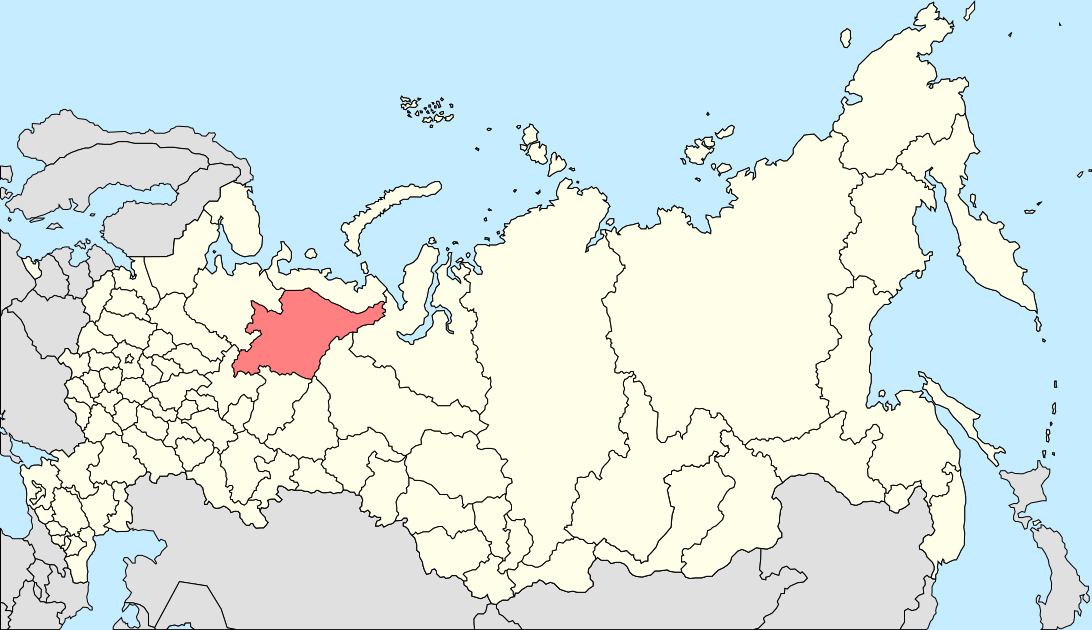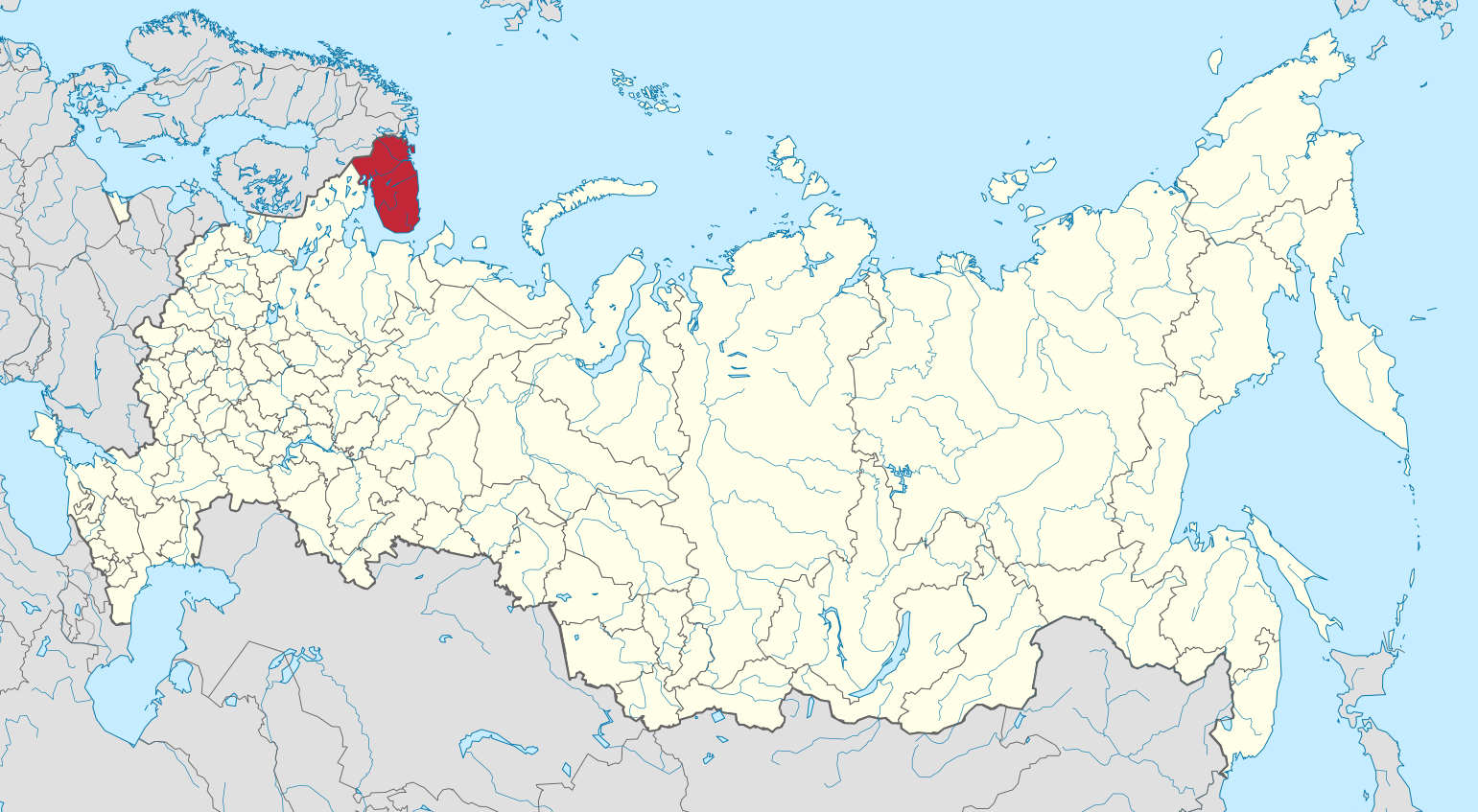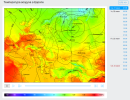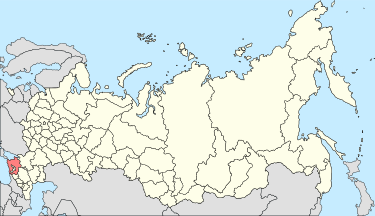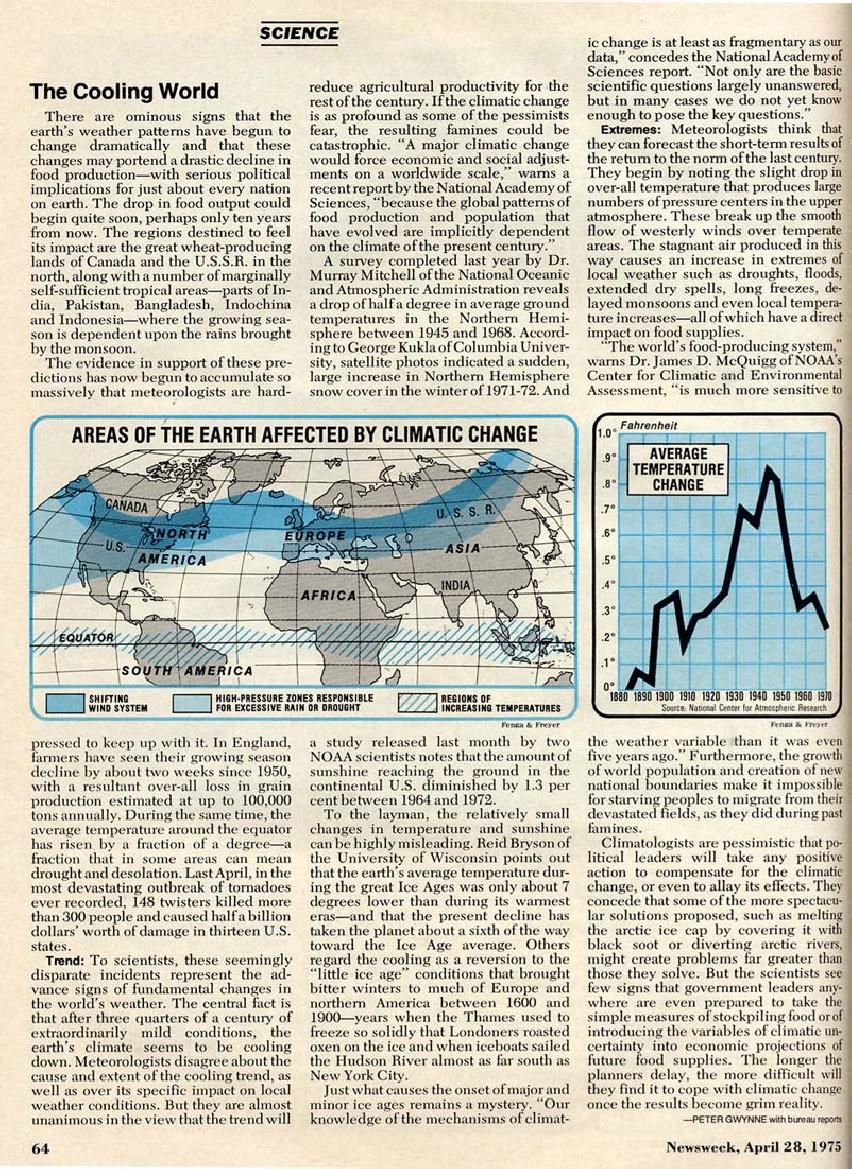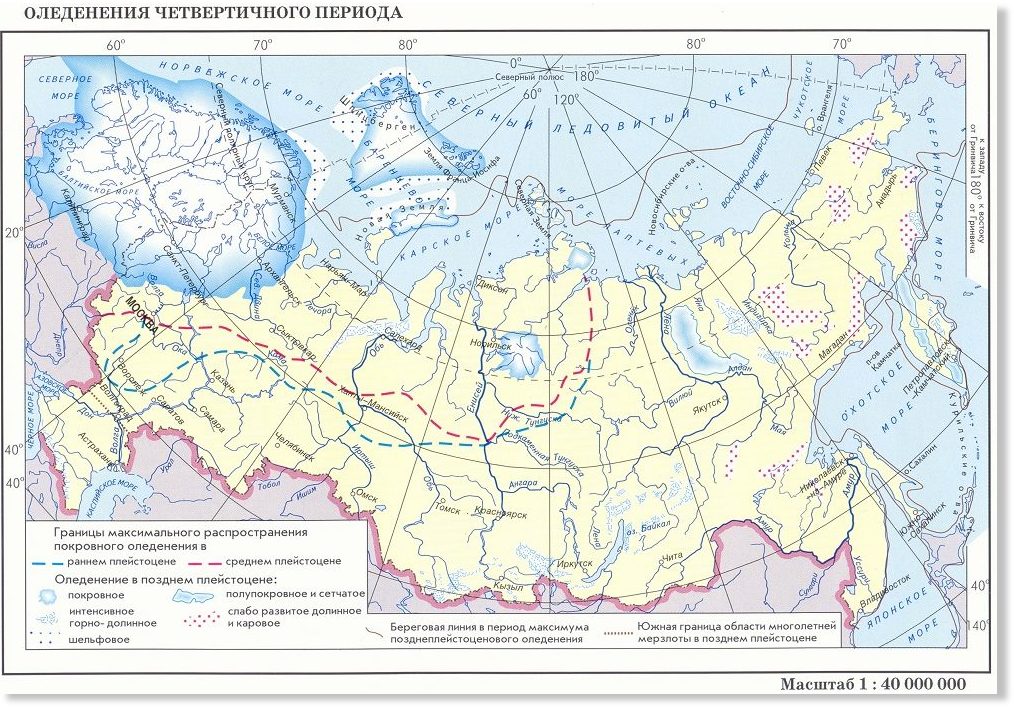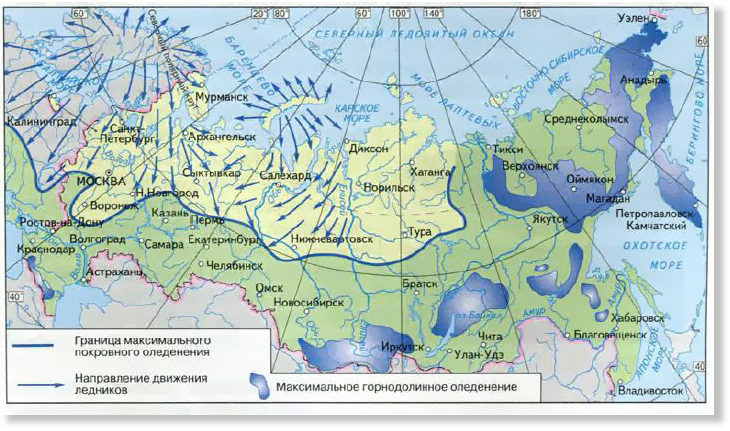Last year was the hottest on record for the third consecutive pass of the calendar. Glaciers and polar ice melt, plant and animal species go extinct at a rapid rate, and sea levels rise. Clearly the consequences of climate change are immense.
Does anyone out there think we’re at the dawn of a new ice age?
If we had asked that question just 40 years ago, an astonishing number of people — including some climatologists — would have answered yes. On April 28, 1975, Newsweek published a provocative article, “The Cooling World,” in which writer and science editor Peter Gwynne described a significant chilling of the world’s climate, with evidence accumulating “so massively that meteorologists are hard-pressed to keep up with it.” He raised the possibility of shorter growing seasons and poor crop yields, famine, and shipping lanes blocked by ice, perhaps to begin as soon as the mid-1980s. Meteorologists, he wrote, were “almost unanimous” in the opinion that our planet was getting colder. Over the years that followed, Gwynne’s article became one of the most-cited stories in Newsweek’s history.
And Gwynne’s was no lone voice, at least in the popular press. Scores of similar articles, some with even more dire predictions of a “little ice age” to come, appeared during the 1970s in such mainstream publications as Time, Science Digest, The Los Angeles Times, Fortune, The Chicago Tribune, New York Magazine, The New York Times, The Christian Science Monitor, Popular Science, and National Geographic. A worldwide freeze proved irresistible to feature writers prowling for a sexy news peg. “The media are having a lot of fun with this situation,” observed climatologist J. Murray Mitchell.
We now see that these forecasts were badly off course, but how did climate science go so wrong? The quick answer is that it didn’t.
A Young Science
The scientific study of the climate is not very old. Compilations of global temperature data started in the 1870s, and not until 1963 did J. Murray Mitchell bring together information from hundreds of weather stations around the world to build a modern representation of Earth’s temperature. His work suggested a steady increase in global temperatures from around 1880, followed by a cooling of the planet from about 1940. In addition, satellites of the early 1970s spotted more snow and ice across the Northern Hemisphere, and people were well aware of unusually harsh winters in North America during 1972-73.
Consequently the suspicion of a cooling world spread among a small number of researchers, but a close look at the data revealed flaws in such a conclusion. The cooling was regional, confined mainly to the Northern Hemisphere, whose chilly temperatures tugged down the world averages. In other parts of the world, temperatures continued to climb. Air pollution and the use of aerosols, reduced by legislation to come in the 1970s and ‘80s, may also have been a factor.
Some years before, scientist Charles David Keeling, measuring the atmosphere from posts atop Mauna Loa and in Antarctica, launched an investigation of changes in the levels of carbon dioxide. By 1965 he had found that CO2 was rapidly increasing. A presidential scientific advisory committee that same year advised that a calamitous rise in temperatures worldwide, from CO2-related emissions, could result.
How prevalent then were worries about global warming? An examination of peer-reviewed scientific literature conducted by a group of researchers in 2008, covering the mid-1960s through the 1970s, revealed that papers warning of global warming outnumbered those projecting cooling by a factor of six. So climate change in the form of global warming was a widespread topic of concern during this era, and there was no consensus that the Earth would cool in the immediate future.
Disbelievers Add Complications
In later years, though, climate change deniers latched upon the 1970s speculations of a cooling planet as a way to discredit scientists who raise the alarm over increasing global temperatures. Some contrarians point to an international conspiracy they say is trying to suppress evidence of a supposed consensus on global cooling. Not only is global warming wrong, these deniers argue, but the exact opposite of warming may be happening — and in any case, how can we believe scientists who claim one thing in one decade and something completely different in another? Or who predicted one disaster that never happened, and now forecast another?
The study of the world’s climate was still primitive in the 1970s. Few meteorological scientists then knew how to interpret trending temperature information, and the cause of climate changes was mysterious. The information that climate researchers had collected was incomplete and easy to misread. The biosciences have advanced by huge leaps since then, and many more scientists now study the climate.
Today, with far better technologies and information available, such organizations as the National Academy of Sciences, the American Association for the Advancement of Science, the National Climate Assessment, and the American Meteorological Society, to name just a few, have declared that the evidence is strong that human activity is causing climate change and higher atmospheric temperatures. No peer-reviewed article advancing evidence for a cooling world has been published in a reputable scientific publication for decades. Meanwhile, thousands of studies offering evidence of global warming have appeared in those same pages, and observable changes have already resulted. Surveys in 2009 and 2010 showed that 97 percent of climate scientists believe that human activity is causing global warming. That’s an overwhelming majority.
A Humbling Recantation
In this light, the Newsweek article of 1975 is a fascinating and meaningful artifact of a scientific era of the past. True, making fun of wrong predictions is easy and amusing. For journalists, it’s often humbling to revisit old work, especially stories more than 40 years old. But in recent years Peter Gwynne mustered the courage to look again at “The Cooling World.” Writing in Inside Science Minds, an independent editorial publication of the American Institute of Physics in 2014, he explained how he produced the 1975 article.
“While the hypotheses described in that original story seemed right at the time,” Gwynne explained, “climate scientists now know that they were seriously incomplete. Our climate is warming — not cooling, as the original story suggested.” Put simply, he said, climate science evolved and advanced, resulting in new knowledge.
(One of the climate scientists whose research Gwynne cited in the Newsweek article long maintained that some aspects of the story were basically correct. But George Kukla, who had observed the satellite photos showing increased snow cover over North America during the early 1970s, denied believing that a sustained period of significant cooling had been imminent. He told an interviewer in 2007 that “none of us expected uninterrupted continuation of the trend.” Instead, he viewed the warming that followed as a cyclical and mostly naturally occurring prelude to the start of a cool-down that will become apparent in the middle of this century.)
Gwynne admitted that although his article accurately captured threads of meteorological thinking from the 1970s, “I didn’t tell the full story back then.” He left out the suggestive, but not then conclusive, evidence of CO2 increases in the atmosphere. He could not have possibly known that initiatives to reduce air pollution would quickly erase the blip of cooler temperatures in North America and help send temperatures up. Gwynne also said he was over-enthusiastic in writing his Newsweek article and incorrectly suggested a connection between global cooling and severe weather in the U.S. — an unjustified leap. “I also predicted a forthcoming impact of global cooling on the world’s food production that had scant research to back it,” he wrote.
Everyone makes mistakes, science writers being no exception, but Gwynne confessed to feeling most embarrassed by climate change deniers’ strange embrace of his article. For instance, U.S. Senator James Inhofe, R-Oklahoma, quoted a 1974 Time Magazine article that asked ‘Is Another Ice Age Coming?’ on the floor of the Senate in 2015 while speaking against climate change — just after holding up a snowball as evidence that it still gets cold outside. Nine years earlier, Newsweek felt it necessary to publish an explanation of the story’s poor prognostications. “I fear that my obituary will be dominated by that single article in Newsweek,” Gwynne wrote.


